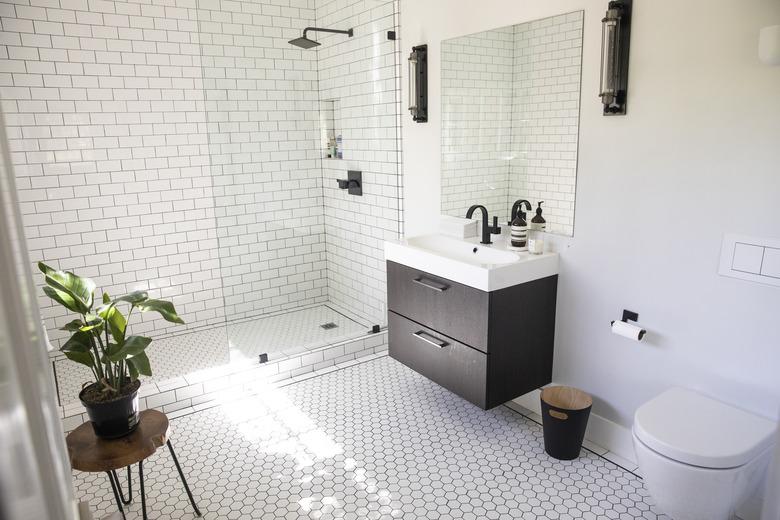How To Remove Or Paint Plastic Laminate Walls In A Bathroom
We may receive a commission on purchases made from links.
Plastic laminate sheets make for durable, water-resistant wall coverings that can emulate the look of any surface. Because of this, they're used often in moisture rich areas, even on shower walls, as an inexpensive, quickly applied building material. Over time, however, you may wish to change the look of the walls as part of your bathroom remodeling project. To make this change, you can either remove the laminate or paint the material.
Removing the panels requires that you break the bond between the plastic and the walls with a bit of solvent. Painting the laminate can take a little more work because of the preparation of the panels beforehand. Either choice can provide you with the change in appearance you desire, giving your walls the new look you desire.
Removing Plastic Laminate
1. Use a Putty Knife
Slip the edge of a putty knife beneath a corner of the laminate panel and move the knife beneath the edge of the panel to create a small gap between the panel and the wall. Remove the panel by gently prying it away from the wall, but if the panel is securely glued and the panel cannot be easily pried away, don't force it and damage your walls. Instead, use an adhesive remover to dissolve the adhesive.
2. Dissolve Adhesive With Acetone
Fill a spray bottle with acetone or use an aerosol adhesive remover. Slide a wide paint scraper into the gap, and then wedge the laminate up slightly to widen it. Spray the acetone into the gap so that it soaks under the laminate into the contact cement binding the laminate to the wall. Wait one minute for the acetone to dissolve the cement slightly.
3. Cut Through the Softened Adhesive
Move the scraper beneath the laminate, cutting through the acetone softened cement to separate the laminate from the wall. Spray more acetone beneath the laminate whenever you reach unaffected contact cement on the wall. Work from the outside of the panel inward until you fully separate the laminate from the wall, and then pull the laminate away.
4. Remove Adhesive From Walls
Remove the contact cement still on the wall by spraying the acetone directly on to the cement and scraping it away with the paint scraper after a minute. Wait for the wall to dry and then sand the surface with a hand-held sander with medium-grit sandpaper attached.
Painting Plastic Laminate
1. Clean the Laminate Panels
Put on a pair of rubber gloves and then wash the plastic laminate panels with a mixture of 1/2 cup trisodium phosphate (TSP) and 1 gallon warm water to remove any dirt or oil. Rinse the panels with clean water after washing and then pat them dry with a towel.
2. Sand the Panels
Sand the surface of the panels with 150-grit sandpaper to create a rough texture for paint adherence. Wash again with the TSP mixture to remove any sanding residue, rinse with water and pat the panels dry.
3. Protect Flooring and Baseboards
Lay a drop cloth along the base of the wall and then place painter's masking tape along the edges of any surfaces adjacent to the panels.
4. Sand and Apply a Primer
Apply a layer of super adherent latex primer to the panels using either a paint sprayer or a paint roller fitted with a low-nap roller cover. Apply the primer in rows using two or three thin overlapping layers to build up a coat of the primer. Wait two hours between each layer for the primer to dry slightly. Wait two days after the last layer for the primer to cure. Sand the primer with 220-grit sandpaper to smooth the primer surface. Remove any signs of buildup, or lines left from the roller with the sandpaper. Wipe the panels with a clean cloth to remove any residue from sanding the paint.
5. Paint the Panels
Paint the panels with two coats of interior latex paint using the same process as that used to apply the primer. Allow the paint to dry completely before using the surface.
